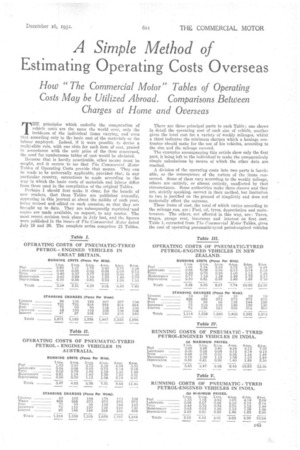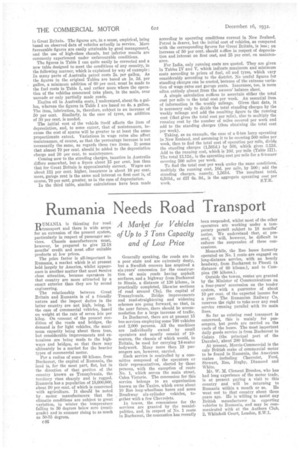A Simple Method of
Page 91

Page 92

If you've noticed an error in this article please click here to report it so we can fix it.
Estimating Operating Costs Overseas
How "The Commercial Motor" Tables of Operating Costs May be Utilized Abroad. Comparisons Between Charges at Home and Overseas THE principles which underlie the computation of vehicle COSTa are the same the world over, only the incidence of the individual items varying, and even that according only to the basic cost of the materials or the labour employed. Indeed, if it were possible to devise a multi-slide rule, with one slide for each item of cost, graded in accordance with the unit price of the item concerned, the need for cumbersome tables of cost would be obviated.
Because that is hardly practicable, other means must be sought, and it occurs to me that The Commercial Motor Tables of Operating Costs provide that means. They can be made to be universally applicable, provided that, in any particular country, corrections be made according to the way in which the basic costs of materials and labour differ from those used in the compilation of the original Tables.
. Perhaps I should first make it clear, for the benefit of new readers, that these Tables are published annually, appearing in this journal at about the middle of each year, being revised and edited en each occasion, so that they are brought up to date. They are subsequently reprinted •and copies are made available, on request, to any reader. The most recent revision took place in July last, and the figures were published in the issues of The Commercial Motor dated July 19 and 26. The complete series comprises 21 Tables,
There are three principal parts to each Table: one shows in detail the operating cost of each size of vehicle, another gives the total cost for a variety of weekly mileages, whilst a third indicates the minimum charges which a haulage contractor should make for the use of his vehicles, according to the size and the mileage covered.
The examples accompanying this article show only the first part, it being left to the individual to make the comparatively simple calculations by means of which the other data are reached.
A division of the operating costs into two parts is inevitable, as the consequence of the nature of the items concerned. Some of them vary according to the weekly mileage, others are entirely, or almost entirely, unaffected by that circumstance. Some authorities make three classes and they are, strictly speaking, correct in their method, but limitation to two is justified on the ground of simplicity and does not materially affect the outcome.
These items of cost, the total of which varies according to the mileage run, are : Fuel, oil, tyres, depreciation and maintenanee. The others, not affected in this way, are: Taxes, wages, garage rent, insurance and interest on first cost. Table I, extracted from The Commercial Motor Tables, gives the cost of operating pneumatic-tyred petrol-engined vehicles
in Great Britain. The figures are, in a sense, empirical, being based on observed data of vehicles actually in service. More favourable figures are easily attainable by good management, and the use of high-class chassis, but inferior results are commonly experienced under unfavourable conditions.
The figures in Table I can quite easily be corrected and a new table designed to meet the conditions of any country, in the following manner, which is explained by way of example : In many parts of Australia petrol costs 2s. per gallon. As the figures in the original Tables are based on is. 3d. per gallon, a minimum addition of 60 per cent. must be made to the fuel costs in Table 1, and rather more where the operation of the vehicles concerned take place, in the main, over unmade or only partially made roads.
Engine oil in Australia costs, I understand, about 6s. a gallon, whereas the figures in Table I are based on 4s. a gallon. The item, lubrication, is, therefore, subject to an increase of 50 per cent. Similarly, in the case of tyres, an addition of 30 per cent, is needed.
The initial cost of the vehicle itself affects the item of depreciation, and, to some extent, that of maintenance, because the cost of spares will be greater to at least the same proportionate extent. Variations in wage rates also affect maintenance, of course, so that the percentage increase is not necessarily the same, as regards these two items. It scenic that almost 70 per cent, should be added to the depreciation charge and 30 per cent, to maintenance.
Coming now to the standing charges, taxation in Australia differs somewhat, but a figure about 15 per cent, less than that for Great Britain is approximately correct. Wages are about 12i per cent. higher, insurance is about 10 per cent. more, garage rent is the same and interest on first cost is, of course, 70 per cent. greater, as in the case of depreciation.
In the third table, similar calculations have been made according to operating conditions current in New Zealand. Petrol is dearer, but the initial cost of vehicles, as compared with the corresponding figures for Great Britain, is less ; an Increase of 50 per cent. should s office in respect of depreciation and interest on first cost, and 25 per cent, on maintenance.
For India, only running costs are quoted. They are given in Tables IV and V, which indicate maximum and minimum costs according to prices of fuel, oil and tyres, which vary considerably according to the district. No useful figures for standing charges can be auoted, because of the extreme variation of wage rates and garage rents. Insurance, too, is more often entirely absent from the owners' balance sheet.
A simple calculation suffices to ascertain either the total cost per mile ot the total cost per week. An essential item of information is the weekly mileage. Given that data, it is necessary only to divide the total standing charges by the weekly mileage and add the resulting figure to the running cost (that gives the total cost per mile), also to multiply the running cost by the number of miles covered per week and add to the standing charges (thus obtaining the total cost per week). Taking, as an example, the ease of a 6-ton lorry operating in New Zealand, and assuming it to be covering 500 miles per week, then to find the total cost of operation per mile, divide the standing charges (1,561d.) by 500, which gives 312d. Add to the running cost, which is 10th per mile (Table III). The total 13.12d., is the operating cost per mile for a 6-tonner covering 500 miles per week. To find the total cost per week under the same conditions, multiply, the running cost, 10d. per mile, by 500; add the standing charges, namely, 1,561d. The resultant total, 6,561d., or £27 6s. 9d., is the aggregate operating cost per week. S.T.R.




























































































































































